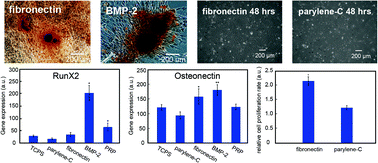Abstract

The ability to induce osteointegration was introduced to a parylene-C surface via the simple and intuitive process of protein adsorption mediated by hydrophobic interactions. In this way, bone morphogenetic protein (BMP)-2, fibronectin, and platelet-rich plasma (PRP) could be immobilized on parylene-C surfaces. This approach alleviates concerns related to the use of potentially harmful substances in parylene-C modification processes. The adsorbed protein molecules were quantitatively characterized with respect to adsorption efficacy and binding affinity, and the important biological activities of the proteins were also examined using both early and late markers of osteogenetic activity, including alkaline phosphatase expression, calcium mineralization and marker gene expression. Additionally, the adsorbed PRP exhibited potential as a substitute for expensive recombinant growth factors by effectively inducing comparable osteogenetic activity. In addition to the excellent biocompatibility of parylene-C and its ability to coat a wide variety of substrate materials, the modification of parylene-C via protein adsorption provides unlimited possibilities for installing specific biological functions, expanding the potential applications of this material to include various biointerface platforms.
.png)

